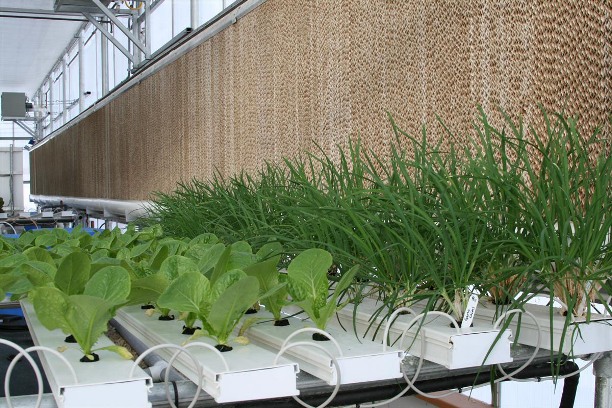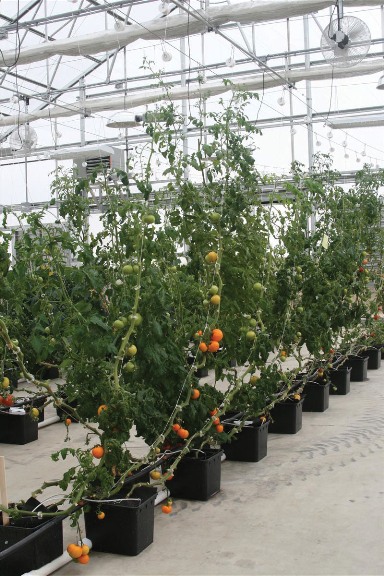
With movements like “Buy Local” and “Know Your Farmer,” producers are working hard to meet consumer demands. This means looking for ways they can grow and sell more produce—especially during off-peak seasons when crops command a high price. Hydroponics is the best growing method for people who wish to diversify or extend their growing operation.
Hydroponics is by no means a new way to grow plants. It is said that the hanging gardens of Babylon were hydroponic. The Aztec grew in floating rafts on ponds and their descendants, the Iantha, are still growing by these means today. While hydroponics is nothing new, the science has certainly been refined and perfected over the recent centuries as botanists learn exactly what nutrients plants need for optimal growth. People are now using 90-95% less water when growing hydroponically than growing in field culture.
Reasons to Grow Hydroponically
Crop Quality
Crop quality is one great reason. By optimizing the fertilizer program to meet the plants’ requirements, growers can produce larger, more nutrient-dense crops and ultimately increase the overall volume of production space. Another reason one may chose to grow hydroponically is the increased level of control over crops. To some degree, environmental factors are taken out of the equation by growing in a controlled environment such as a greenhouse. You can grow awesome crops year round, right in your basement, with the proper lights and ventilation.
Optimize Space
Another reason that a proactive gardener may want to experiment with hydroponics is to optimize growing space. By growing vertically, you get the most out of your growing space. You can utilize multiple-layered systems and stack one tier of plants on top of another. In fact, I recently had a three-tiered lettuce table that worked great.
Reduce Labor Costs
Growing hydroponically also helps reduce labor costs. There is no weeding involved and there are minimal pest and disease issues. For instance with lettuce, once you transplant your seedling into your growing system, there is very little work to be done for the remaining 4 to 5 weeks until it is ready to harvest.
Using an NFT System
In our growing operation, most of our lettuce is grown using the nutrient film technique (NFT). In this method, the nutrients are supplied to the plants through a thin film of a pH-adjusted water and nutrient solution that constantly bathes the roots. Our larger greenhouse has 2,550 sites for lettuce and other leafy-green production. We average about six weeks from seed to harvest, so we grow around 20,000 heads of lettuce per year out of our system. We also grow basil, rosemary, cilantro, green onions, chives, Swiss Chard, Kale and even Nasturtium for their edible flowers. I have to admit that I never had that much luck growing rosemary in my home garden but growing it hydroponically has been a breeze. We just trim it back and let it regenerate.
Some of the benefits of the NFT growing include a waist-level work space with easy access to the plant roots for examination, the ability to layer channels in a vertical space and a large variety of different sized crops can be grown in the same system by using different sized channels NFT channels. NFT systems are also easy to use with aquaponics.

We use the Dutch (or bato) bucket method for growing our larger fruiting crops. This technique is often utilized for the crops that will be around the greenhouse for a longer period of time. Greenhouse tomatoes for instance can grow up to eighteen months and beyond. We don’t push them quite that long and generally grow two crops of tomatoes per year.
We use the grow-bag technique for our strawberry production. The grow-bags are filled with rockwool which has a great moisture and nutrient-holding capacity and provide a good environment for strawberries. They are easy to manage and harvest. You can even chill them down for a couple weeks after they are done fruiting and get them to set fruit again. Growing fresh strawberries all year round is well within your reach with hydroponics. The strawberries have a constant supply of nutrients so you don’t have to worry about exhausting the plants. They get everything they need from the hydroponic solution. With a little research and practice, you will be able to time it so that you are perpetually harvesting those little gems.
Our newest adventure in the greenhouse department has been our aquaponic growing. As you know, hydroponics is growing plants without soil utilizing a nutrient solution. Aquaculture is the farming of fish. Aquaponics is a blend of the two where you grow fish and plants together with the fish being the source of fertilizer. It is truly a symbiotic relationship where the fish feed the plants and the plants filter the water for the fish. We are currently growing tilapia which can grow from .5 grams to 2 lbs. in only 9 months! Every pound of fish food you put in the tank puts a pound of meat on the fish. It is a very sustainable way to grow with relatively low inputs. It can also be considered organic in some instances. Most importantly, it helps to reduce the burden on global fish market. The current system I am growing in will produce up to 4000 heads of lettuce a year and 450 lbs of fish.
Hydroponics has been around for hundreds of years and is still being refined today. The demand for locally grown produce and having a relationship with where your food comes from has certainly helped to spurn this resurgence. The bottom line is that people want to know their farmer. Why not take advantage of this trend and consider growing year round? Why not get a hydroponic or aquaponic kit and start your perpetual harvest, all while teaching sustainability to your children, grandchildren and yourself.
Sam Shroyer has a bachelor’s degree in horticulture from South Dakota State University and 20 years of horticultural experience, it is his goal to “re-teach” the public that sustainability and self-sufficiency is well within everyone’s reach.
Related Article & Free Email Newsletter
Grow Systems and Supplies for Successful Home Hydroponics
Hydroponic Terminology – Let’s be sure we are Speaking the Same Language!




Comment here